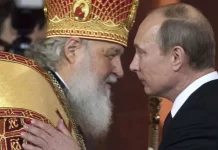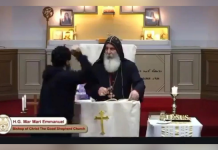Prayer the Church’s banquet, Angels’ age,
God’s breath in man returning to his birth,
The soul in paraphrase, heart in pilgrimage,
The Christian plummet sounding heaven and earth;
Dennis Lennon, Turning the Diamond, continues:
The first sparkle from George Herbert’s diamond gave exotic images of prayer as feasting, and as angelic longevity. The second facet of his stone could not be more different in its plain simplicity: prayer is like breathing. It is “God’s breath in man returning to his birth.” This is prayer as rejuvenation.
Nothing is more elusive than the over-familiar, well-worn thing. “Breathing” is a humdrum, thirty-thousand-times-a-day activity and thereby virtually impenetrable to the imagination….
One breath comes to us as the Father’s gift and returns to him when freighted with our prayer, love and praise. The fact that we live in complete moment-by-moment dependence upon the vital power of “God’s breath in man” means that we will understand our existence when we see its giftedness. The fact that we are breathing, at this moment, is the ever-present reminder of our utter indebtedness to God. Thanksgiving becomes a driving force within us. We breathe, we lift up our voices in prayer; our breathing follows the great doxological contour: “For from God, and through him and to him are all things. To him be glory for ever! Amen.” (Romans 11:36).
Prayer is thus the most normal and natural use of our breath. The act of prayer throws open the windows of our interior world, ventilating our spirit, allowing our breath to surge through us and out on its short return journey to God. Here is the homing instinct of the prayers we breathe; like a child running to her mother’s arms; like a magnetic needle searching about until it settles on north….
So far, in following Herbert’s metaphor, we have thought of breathing as making speech, prayer and praise, possible for us. But of course breath is the vital power of our entire bodily life, and properly understood our entire bodily life comes into play when we pray. Prayer is the total response of the whole person to God within the full range of lived experience. In Abraham Kuyper’s words, “There is not an inch of any sphere of life to which Jesus Christ does not say ‘mine!’”….
Think of the will of God for each of us as a piece of music, written personally by a composer who knows each one’s distinctive instrument. That instrument is your uniquely designed and gifted body, engineered by “God’s breath in man,” intended for communion with God in a relationship of love. Nothing else will serve as an instrument on which to interpret and perform the music. “Sacrifices and offerings you did not desire,” said Jesus, because they are less than the image of God….
Prayer lived out through the entirety of bodily life transcends those artificial partitions by which we divide up our discipleship (e.g., into Bible reading, church, witness, service, mission, etc.). Behaviour-prayer reintegrates our trivialized and fragmented personal world because now everything relates around the centre of Christ’s love.
But are we still missing something in Herbert’s words? By now we know enough of his thoughts to expect rich subtleties and depths within his apparent simplicities. The idea of breath returning to “his birth” is puzzling. Breath, after we have done with it, is normally exhaled to its “death” not its birth. When it has fulfilled its mission and spent itself delivering its oxygen to keep us ticking over a little longer, breath is finished. Exhaled, it is absorbed back into the atmosphere.
But prayer, Herbert says, reverses that natural process of deterioration and exhaustion, which leads to the “death of breath.” Prayer takes it back the other way to “his birth,” the place of regeneration and new beginnings. Prayer is the agent of rejuvenation because it puts the one who prays into communion with the risen Christ, the Lord of life. “He…set his seal of ownership on us, and put the Spirit in our hearts as a deposit, guaranteeing what is to come” (2 Corinthians 1:22). “What is to come” and is already at work among us, is the continual feast of resurrection life. To be a Christian is to be always young, in a sense far more profound than mere biological youthfulness…. Prayer is the language of Christian newness by which “God’s breath in man” goes one way, back to birth.
Even at his death, Jesus was a young man. His vision, words and acts were never entirely at home within the disenchanted adult world. Irenaeus said about Jesus, “Know that he brought all newness by bringing himself.” His heart was bursting with the paradoxes of God’s inventions, the exhilarating and subversive upside-down-ness of the kingdom: that we will find ourselves when we throw ourselves away on to the will of God, and so on. The rigid, conformist, and above all the self-centred mind (the aging mind) cannot cope with him. His newness is spliced into this present sin-damaged time of ours and is not an easy fit….
Jesus said on the secret of eternal young-ness, “Do not store up for yourselves treasures on earth, where moth and rust destroy, and where thieves break in and steal. But store up for yourselves treasures in heaven, where moth and rust do not destroy, and where thieves do not break in and steal. For where your treasure is, there your heart will be also” (Matthew 6:19-21). Prayer as a way of life, a way of the heart, as “God’s breath in man returning to its birth,” takes our essential life back and up, against the processes of “moth and rust,” into the inexhaustible, rejuvenating life of Christ.
This meditation recalls to me the great hymn of joyful dedication by Frances Ridley Havergal, “Take My Life”:
Take my life and let it be
Consecrated, Lord, to thee.
Take my moments and my days;
Let them flow in endless praise,
Let them flow in endless praise.
On Day Four, we shall turn to “The soul in paraphrase, the heart in pilgrimage.”










